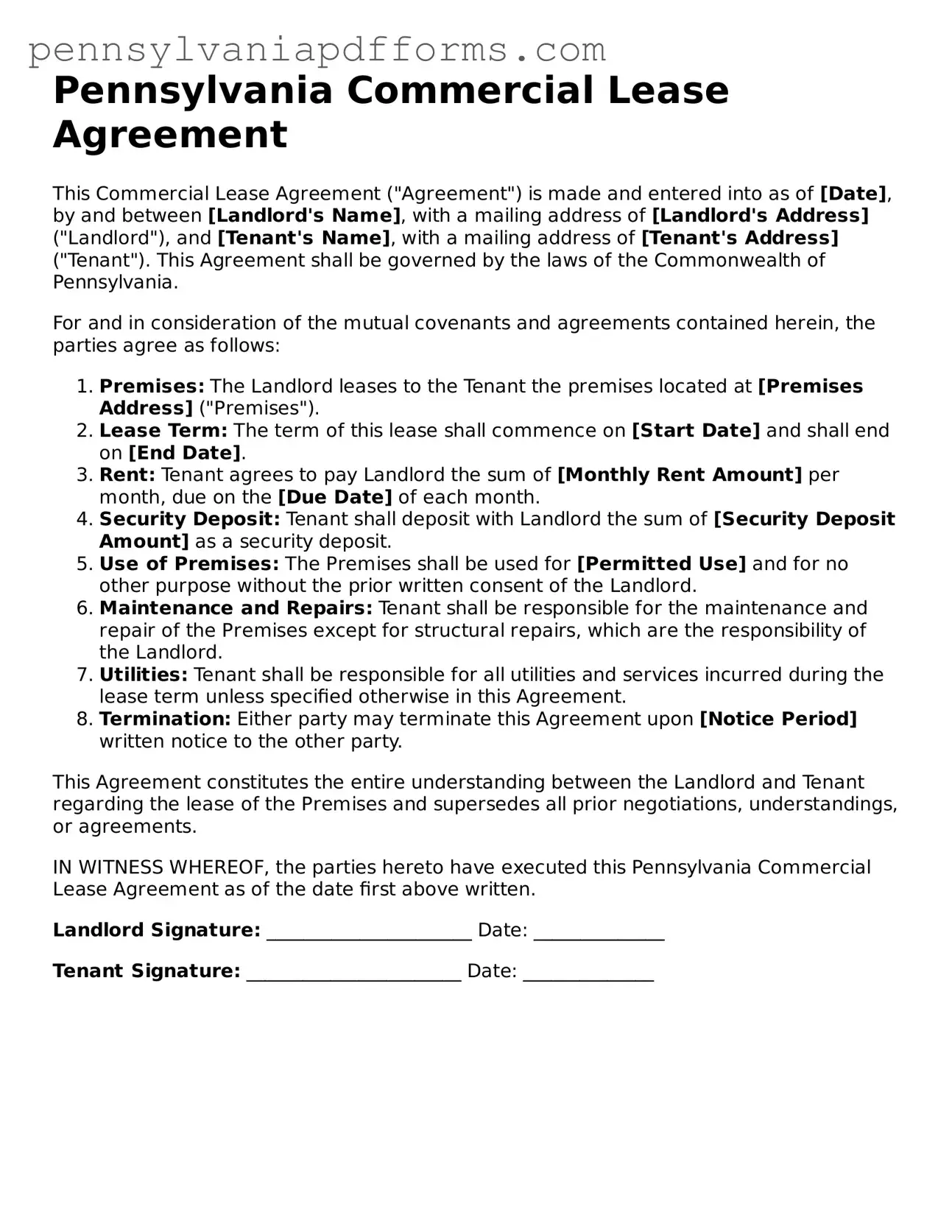A Pennsylvania Residential Lease Agreement is similar to a Commercial Lease Agreement in that both documents outline the terms under which a property is rented. While a Commercial Lease Agreement is tailored for business use, the Residential Lease Agreement focuses on living spaces. Both agreements specify the duration of the lease, the amount of rent, and the responsibilities of the landlord and tenant. They provide a framework for resolving disputes and outline conditions for terminating the lease, ensuring that both parties understand their rights and obligations.
A Rental Agreement is another document that shares similarities with a Commercial Lease Agreement. This type of agreement can be either written or verbal and typically covers a shorter duration than a lease. Both documents detail the rental terms, including payment schedules and property maintenance responsibilities. However, a Rental Agreement is often more flexible, allowing for month-to-month arrangements, whereas a Commercial Lease Agreement usually involves a longer commitment.
A Sublease Agreement is akin to a Commercial Lease Agreement in that it allows for the rental of a property, but it involves an existing tenant renting out their leased space to another party. This document must comply with the original lease terms and requires the landlord's consent. Both agreements outline the rights and responsibilities of the parties involved, ensuring clarity on issues such as rent payments and property maintenance.
A Lease Assignment Agreement is similar in that it transfers the lease obligations from one tenant to another. This document is particularly relevant in commercial settings where businesses may change ownership or require a new tenant to take over the space. Like a Commercial Lease Agreement, it details the terms of the lease and ensures that the new tenant understands their responsibilities while protecting the landlord’s interests.
A Property Management Agreement also shares characteristics with a Commercial Lease Agreement. This document outlines the relationship between a property owner and a management company tasked with overseeing the property. Both agreements define responsibilities, including rent collection and property maintenance, ensuring that the property is well-managed and that tenants receive the services they expect.
A Confidentiality Agreement, often used in commercial settings, is similar to a Commercial Lease Agreement in that it protects sensitive information. While the lease agreement focuses on the rental terms, a Confidentiality Agreement ensures that proprietary business information remains private. Both documents establish clear boundaries and expectations, safeguarding the interests of the parties involved.
The Pennsylvania Residential Lease Agreement serves a similar purpose to the Commercial Lease Agreement but is tailored for residential properties. Both documents define the terms of the lease, including rent, duration, and responsibilities of tenants and landlords. Key differences lie in the nature of the premises; while the residential agreement focuses on homes or apartments, the commercial version is designed for business use. Additionally, residential leases often have more regulations protecting tenants compared to commercial leases. For those seeking a comprehensive overview, the PDF Document Service can be an invaluable resource.
A Purchase Agreement can be compared to a Commercial Lease Agreement in that both involve the exchange of property rights. While a Purchase Agreement facilitates the sale of a property, a Commercial Lease Agreement allows a tenant to use the property without transferring ownership. Each document outlines specific terms and conditions, ensuring that both parties understand their commitments and rights.
A Partnership Agreement may also be similar to a Commercial Lease Agreement, especially when businesses collaborate to share a commercial space. Both documents define the terms of the partnership or lease, including financial responsibilities and operational duties. This ensures that all parties are on the same page regarding their roles and the management of the shared space.
A Joint Venture Agreement can be compared to a Commercial Lease Agreement as it involves two or more parties working together towards a common goal, often in a commercial property context. Both agreements outline the terms of collaboration, including financial contributions and profit-sharing. Clarity in these documents helps prevent misunderstandings and ensures that all parties are aligned in their objectives.
Finally, a Business License Application, while not a lease document, is related to the Commercial Lease Agreement in that it is often required for businesses operating in a leased space. Both documents are essential for establishing a legal framework for the business. The Business License Application ensures compliance with local regulations, while the Commercial Lease Agreement outlines the terms of occupancy, making them both critical for a successful business operation.
